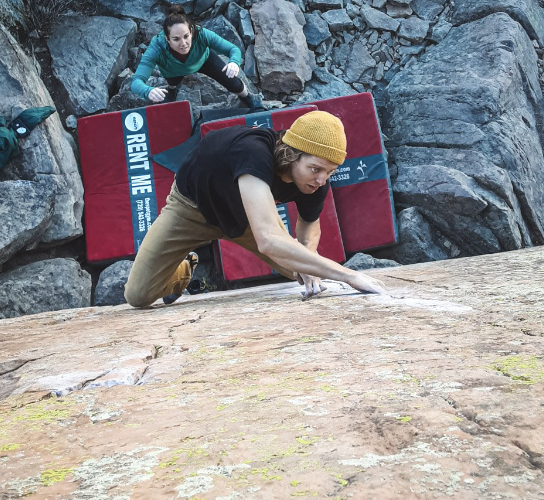Crash Pads for Bouldering
Crash pads are essential for bouldering.They’ll provide you with a cushioned landing zone to help protect you when you fall.
Here’s what you need to know about them:

Types of Crash Pads
Taco-Style Pads: fold in half like a taco shell, with the foam inside remaining in a single piece.
Pros: no creases in the landing surface, generally more durable.
Cons: bulkier to transport, can take up more space.
Hinge-Style Pads: have a hinge in the middle, allowing them to fold flat for easier transport.
Pros: easier to carry and store as they’re usually more compact.
Cons: the hinge can create a weak spot where it might not absorb impacts as effectively.
Hybrid Pads: combine features of both taco and hinge pads, often using a Velcro strap to secure the folding mechanism.
Pros: aims to offer the best of both worlds—compactness of hinge pads and the continuous foam surface of taco pads.
Cons: they can be more expensive.

Features to Consider
Foam Quality
Types of Foam: crash pads typically use a combination of closed-cell foam (on top for distributing impact) and open-cell foam (on the bottom for cushioning).
Thickness: more foam usually means better protection. Most pads range from 3 to 5 inches thick.
Size
Landing Area: larger pads offer more coverage but can be bulkier to transport. Consider the types of problems you climb and the typical fall zones.
Portability: think about how far you need to carry the pad and how it will fit in your vehicle.
Durability
Material: look for durable outer fabrics like ballistic nylon, which can withstand rough terrain and sharp rocks.
Construction: reinforced stitching and robust buckles/straps are important for longevity.
Additional Features
Backpack Straps: look for shoulder straps or backpack-style straps for easier carrying.
Closure System: velcro straps, buckles, and flaps help keep the pad closed during transport and can secure gear inside.
Extra Pockets: some pads have pockets or pouches for storing climbing shoes, chalk bags, or other small items.

Using Crash Pads Safely
Placement: Ensure the pad is placed directly under the problem's fall zone. For traverses or longer problems, use multiple pads or spotters to move them as you climb.
Spotting: Have a spotter to guide the climber towards the pad and ensure they land safely.
Landing Technique: Aim to land on your feet with knees slightly bent to absorb the impact, and roll if necessary to distribute the force.
Popular Brands and Models
Black Diamond: Mondo, Drop Zone has high-quality foam, durable construction, easy-to-use closure systems.

Metolius: Session II, Recon has innovative hinge designs, comfortable carrying systems and durable materials.

Mad Rock: Triple Mad Pad, R3 has thick foam padding, versatile designs, and some models with modular components.

Organic Climbing: Simple Pad, Big Pad has customizable colors, high-quality foam, and handmade construction.

Crash pads are crucial for bouldering safety, offering protection from falls and reducing the risk of injury. To choose the right pad, consider the type, features, and how you’ll use it in your climbing adventures. Climb On!
